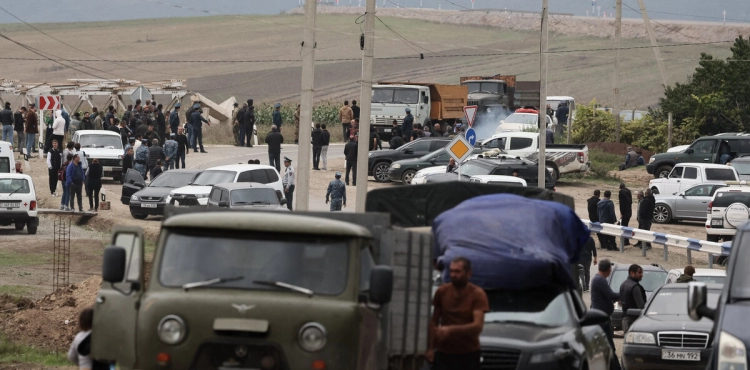On Tuesday, thousands of residents of Nagorno-Karabakh sought to flee their region to Armenia, which announced the reception of more than 28,000 of them, about a week after the lightning attack carried out by Azerbaijan in this separatist region in the Caucasus, the majority of whose residents are Armenians.
On Tuesday evening, Yerevan announced that the number of refugees from Nagorno-Karabakh it had received had exceeded 28,000.
On Tuesday, Paris considered, through Foreign Ministry spokeswoman Anne-Claire Lugandre, that the “massive” exodus of Armenians from Nagorno-Karabakh was taking place “within the eyes of a complicit Russia.”
In 2020, Russia deployed a peacekeeping force in the separatist region.
Logande reminded that Paris will hold "Azerbaijan fully responsible for the fate of the Armenian population."
Paris called for "international diplomatic action" in the face of Russia's "abandonment of Armenia."
For its part, the European Union asked Azerbaijan to detail its “vision” regarding the fate of Armenians residing in Nagorno-Karabakh.
In a statement, the bloc stressed "the necessity of transparency and providing access for international humanitarian aid and officials charged with ensuring respect for human rights and receiving additional details about Baku's vision regarding the fate of the Armenians in Nagorno-Karabakh and Azerbaijan."
An Azerbaijani government source told Agence France-Presse on Tuesday that Azerbaijani border guards are searching for people suspected of committing "war crimes" among the refugees leaving Nagorno-Karabakh for Armenia.
The source said, “Azerbaijan intends to pardon the Armenian fighters who laid down their weapons in Karabakh. But those who committed war crimes during the Karabakh wars must be handed over to us,” while explaining the reasons for asking men of fighting age to look at a camera at the end of the day. Border checkpoint.
On Monday evening, a fuel depot exploded in the enclave amid a mass exodus, killing at least 20 people and wounding 280 others, the separatist authorities announced on Tuesday, calling for urgent foreign assistance to deal with this disaster.
“Dozens of wounded are still in critical condition,” she said in a statement, explaining that the injured suffering from burns of varying severity were transferred to the hospital in Nagorno-Karabakh.
Twenty people were killed, and the bodies of 13 people whose identities were not known will be subjected to forensic analysis, according to the same source.
Earlier Tuesday, Armenian Deputy Prime Minister Tigran Khachatryan said in a statement to television that “the number of forcibly displaced people who arrived in Armenia from Nagorno-Karabakh reached 19,000,” amid a continuous flow of cars carrying families and property to the last Azerbaijani checkpoint before entering Armenian territory. Lachin crossing road.
Some flee on foot. “They expelled us,” a man said as he passed in front of the Azerbaijani soldiers.
These civilians are fleeing Nagorno-Karabakh, despite the promise repeated by Azerbaijan President Ilham Aliyev on Monday, that the rights of Armenians in this enclave occupied by his army will be “guaranteed.”
He was speaking alongside his Turkish counterpart, Recep Tayyip Erdogan, who plays a major role in this part of the Caucasus, a few days after the victory of Azerbaijani soldiers over separatist forces in Nagorno-Karabakh, which is inhabited by a majority of Armenians and which the Soviet authorities annexed to Azerbaijan in 1921.
The European Union is scheduled to receive, on Tuesday in Brussels, senior representatives of Armenia and Azerbaijan, two former Soviet republics that faced off militarily in Nagorno-Karabakh in the period from 1988 to 1994 (30,000 dead) and in the fall of 2020 (6,500 dead).
Simon Mordo, principal diplomatic advisor to European Council President Charles Michel, will chair this meeting in Brussels. Azerbaijan and Armenia, as well as France and Germany, will be represented by their national security advisers. The European Union's Special Representative for the South Caucasus, Estonian diplomat Toivo Klar, is also participating.
For their part, Armenian Prime Minister Nikol Pashinyan and Azerbaijani President Ilham Aliyev will meet on October 5 in Granada, Spain, with the participation of French President Emmanuel Macron, German Chancellor Olaf Scholz and European Council President Charles Michel, a meeting that has been planned for a long time and has not been cancelled. .
Azerbaijan pledged to allow separatists who surrender their weapons to go to Armenia.
Many fear a mass exodus of Armenians from Nagorno-Karabakh, as Azerbaijani forces tighten their grip, while the humanitarian situation remains very difficult.
On Sunday evening, the influx of refugees began to the city of Goris, which has a population of about twenty thousand people and is the first stop for those fleeing Nagorno-Karabakh. After passing through the Kornidzor point just beyond the border, those who “have nowhere to go,” like Valentina Asaryan, are brought here.
Annabelle Golasyan (41 years old), who was displaced from the rural village (Shalfa in Azerbaijani), said, “We lived through terrible days.”
In front of the Goris Theater, minibuses continue to flow. From there, some head to Yerevan and major Armenian cities.
Last week, Pashinyan announced that his country, with a population of 2.9 million people, is preparing to receive 40,000 refugees.
On Monday, Russia, which considers the Caucasus to be a region of influence and deployed a peacekeeping force in Nagoni Karabakh three years ago, rejected the criticism leveled by Pashinyan, accusing it of abandoning its ally.












